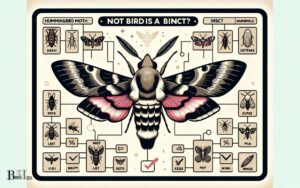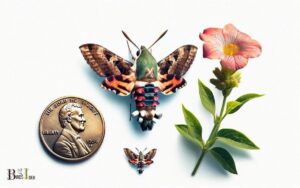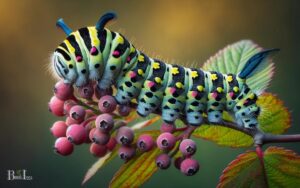White Lined Sphinx Hummingbird Moth: Discover!
The White Lined Sphinx Hummingbird Moth (Hyles lineata) is an insect that closely mimics a hummingbird.
It features prominent white stripes on its wings and body, and is equipped with a lengthy proboscis for feeding on nectar.
These moths are often seen fluttering around flowers during dusk and dawn. Their mimicry of hummingbirds is not just visual; they also share similar flight patterns and feeding behaviors.
As a key pollinator, the White Lined Sphinx Hummingbird Moth contributes to the health of many plant species, despite facing challenges such as habitat destruction and the use of pesticides.
The White Lined Sphinx Hummingbird Moth is notable for its:
Conservation efforts are important for maintaining the ecological balance these moths help to sustain.
Discover the enchanting world of the White Lined Sphinx Hummingbird Moth, a key pollinator with a bird-like allure.

Key Takeaway
Common Features of White Lined Sphinx Hummingbird Moth
| Feature | Description |
|---|---|
| Scientific Name | Hyles lineata |
| Common Name | White Lined Sphinx Hummingbird Moth |
| Classification | Insect |
| Family | Sphingidae |
| Wingspan | Typically 2.5 to 3.5 inches (6.35 to 8.89 cm) |
| Coloration | Brown to gray with white stripes; pink hindwings |
| Proboscis Length | Exceptionally long, adapted for nectar feeding |
| Habitat | Meadows, gardens, open fields, and deserts |
| Distribution | North and South America, from Canada to Argentina |
| Behavior | Nocturnal and crepuscular; mimics hummingbirds in flight and feeding habits |
| Conservation Status | Not currently endangered, but affected by environmental changes |
| Role in Ecosystem | Pollinator for various flowering plants |
Physical Characteristics
The White Lined Sphinx Hummingbird Moth exhibits remarkable adaptability in its physical characteristics to thrive in diverse environments.
With a wingspan of 2-3 inches, it possesses elongated forewings and smaller hindwings, enabling agile and precise flight similar to that of a hummingbird.
Its body, covered in dense scales, aids in thermoregulation and provides camouflage against predators.
The proboscis, extending up to 1.5 inches, allows for efficient nectar extraction from tubular flowers, showcasing its specialized feeding adaptation.
Furthermore, its keen visual perception, attributed to large compound eyes, facilitates navigation during nocturnal foraging.
These physical traits collectively contribute to its success in various ecosystems, from deserts to tropical regions.
Such adaptability underscores the evolutionary prowess of the White Lined Sphinx Hummingbird Moth in harnessing its physical attributes for survival.
Habitat and Distribution
Habitat and distribution for the White Lined Sphinx Hummingbird Moth encompass a wide range of environments, from arid deserts to lush tropical regions.
This species is highly adaptable and can be found in various habitats across North, Central, and South America.
The moth’s distribution is primarily influenced by the availability of its preferred nectar sources and larval host plants.
- Preferred Nectar Sources: The White Lined Sphinx Hummingbird Moth is commonly found in areas abundant with flowering plants such as honeysuckle, petunias, and phlox.
- Larval Host Plants: This species lays its eggs on plants like evening primrose, willow weed, and various types of grasses, which are essential for the development of their larvae.
- Geographical Range: The moth’s distribution spans from southern Canada to Argentina, covering a diverse range of ecosystems, including grasslands, woodlands, and urban gardens.
Life Cycle and Behavior
During its life cycle, the White Lined Sphinx Hummingbird Moth undergoes four distinct stages of development.
It starts as an egg, usually laid on the underside of leaves of host plants such as tomatoes, peppers, and grapes.
After about a week, the egg hatches into a larva, commonly known as a hornworm due to the prominent horn-like structure on its posterior end.
The larva goes through several molts, during which it grows rapidly and consumes copious amounts of plant material.
Once fully grown, the larva burrows into the soil to pupate. The pupa stage lasts for about two weeks, after which the adult moth emerges.
As adults, they’re primarily nocturnal, but can also be seen during the day, especially when feeding on nectar from flowers.
Role in Pollination
The White Lined Sphinx Hummingbird Moth plays a crucial role in pollination as it’s a nocturnal pollinator, allowing for cross-pollination to occur during the night.
With its ability to hover and feed on nectar while in flight, it mimics the behavior of a hummingbird, making it an efficient pollinator for a variety of flowers.
This moth’s visits to different types of flowers also contribute to the diverse pollination of various plant species, highlighting its significance in the ecosystem.
Pollinates at Night
The White Lined Sphinx Hummingbird Moth actively pollinates flowers at night, playing a crucial role in nocturnal pollination.
As a nocturnal pollinator, this moth contributes to the reproductive success of various plant species, particularly those with night-blooming flowers.
This behavior is essential for maintaining the biodiversity of plant species and ecosystem stability.
The moth’s unique ability to navigate and forage during low-light conditions allows it to access nectar sources that aren’t available to diurnal pollinators, thereby increasing the efficiency of pollination in certain plant species.
- Contributes to the survival of night-blooming plants
- Enhances biodiversity and ecosystem stability
- Efficiently accesses nectar sources unavailable to diurnal pollinators
Mimics Hummingbird Behavior
At night, the White Lined Sphinx Hummingbird Moth actively mimics hummingbird behavior to pollinate flowers, contributing to the reproductive success of various plant species.
This moth hovers in front of flowers, using its long proboscis to reach deep into the blooms for nectar. While feeding, it transfers pollen from one flower to another, facilitating cross-pollination.
The moth’s ability to hover and its rapid wing beats closely resemble those of a hummingbird, allowing it to access nectar from a wide variety of flowers.
This behavior is crucial for the reproduction of many plants, as it ensures the transfer of genetic material between individuals and enhances genetic diversity within populations.
Visits Various Flowers
Playing a vital role in pollination, the White Lined Sphinx Hummingbird Moth visits various flowers to transfer pollen, ensuring the reproductive success of multiple plant species.
This moth exhibits a specialized feeding behavior that contributes significantly to the pollination process.
- The long proboscis of the moth allows it to reach nectar in deep flowers, which many other pollinators can’t access.
- As it moves from flower to flower, the moth inadvertently picks up and deposits pollen, facilitating cross-pollination among different plants.
- The moth’s frequent visits to flowers increase the likelihood of successful pollination, leading to the production of seeds and the continuation of plant species.
Understanding the White Lined Sphinx Hummingbird Moth’s role in pollination is crucial for appreciating its ecological significance within various ecosystems.
Interactions With Plants
One intriguing aspect of the White Lined Sphinx Hummingbird Moth’s interactions with plants is its preference for certain nectar-rich flowers.
This moth species exhibits a strong attraction to specific types of flowers due to their high nectar content, which is essential for their sustenance.
The table below highlights some of the preferred flowers that attract the White Lined Sphinx Hummingbird Moth.
| Preferred Flowers | Nectar Content |
|---|---|
| Honeysuckle | High |
| Bee Balm | High |
| Petunia | Moderate |
| Verbena | Moderate |
These flowers provide the necessary nectar to fuel the moth’s activities, making them crucial for its survival.
Understanding the White Lined Sphinx Hummingbird Moth’s floral preferences is essential for conservation efforts and promoting biodiversity in the ecosystem.
What Are the Differences Between White Lined Sphinx Moths and Hummingbirds?
The white lined sphinx moth discovery is intriguing. While both white lined sphinx moths and hummingbirds are known for their hovering behavior, they have distinct differences. Moths are nocturnal, while hummingbirds are diurnal. Additionally, moths have feathery antennae and different feeding habits compared to hummingbirds.
Conservation and Threats
Human activities, such as urbanization and agricultural expansion, have led to the loss of natural habitats for the White Lined Sphinx Hummingbird Moth.
This has significantly impacted the availability of suitable breeding and foraging grounds for the species.
Additionally, the use of pesticides has posed a threat to their populations, as these chemicals can directly harm the larvae and adult moths, as well as reduce the availability of their food sources.
Habitat Loss Impact
The habitat loss impact on the White Lined Sphinx Hummingbird Moth is a significant concern for conservationists and researchers.
As human activities continue to encroach upon natural habitats, the moth’s survival is increasingly threatened.
- Fragmentation of Habitats: Urbanization and agricultural expansion lead to the fragmentation of the moth’s natural habitats, making it difficult for them to find suitable areas for breeding and foraging.
- Disruption of Migration Patterns: Habitat loss disrupts the moth’s migration patterns, leading to a decrease in population and genetic diversity.
- Reduced Food Sources: Loss of natural habitats results in a decline in the availability of nectar-producing plants, which are essential for the moth’s survival.
Conservation efforts must focus on preserving and restoring the moth’s habitats to mitigate the impact of habitat loss and ensure the long-term survival of the White Lined Sphinx Hummingbird Moth.
Pesticide Use Effects
Pesticides pose a significant threat to the White Lined Sphinx Hummingbird Moth, impacting its conservation efforts and overall survival.
These chemicals are often used in agricultural practices to control pests but can have detrimental effects on non-target organisms such as the White Lined Sphinx Hummingbird Moth.
Pesticides can directly kill adult moths and their larvae, reducing population numbers. Furthermore, exposure to sublethal doses of pesticides can impair the moth’s ability to forage, navigate, and reproduce, ultimately affecting its long-term survival.
Moreover, these chemicals can also contaminate the nectar of the moth’s preferred flowers, further affecting their food source.
To ensure the conservation of the White Lined Sphinx Hummingbird Moth, it’s crucial to regulate and minimize the use of pesticides in its habitat.
Conclusion
The white lined sphinx hummingbird moth is a fascinating and vital species in the ecosystem. It plays a crucial role in pollination and interacts with a variety of plants.
Despite its importance, the moth faces conservation threats that require immediate attention. It is truly a wonder of nature that deserves our protection.
Before it becomes just another footnote in the history of biodiversity loss, we must take action to protect and preserve the white lined sphinx hummingbird moth.






